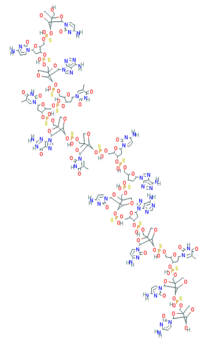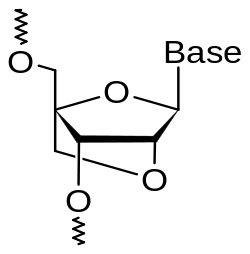Miravirsen
 | |
| Clinical data | |
|---|---|
| Routes of administration | Intravenous or subcutaneous injection |
| ATC code |
|
| Legal status | |
| Legal status |
|
| Identifiers | |
| |
| Synonyms | SPC3649 |
| CAS Number | |
| PubChem CID | |
| UNII | |
| Chemical and physical data | |
| Formula | C151H185N49O83P14S14 |
| Molar mass | 4,896.87 g·mol−1 |
| 3D model (JSmol) | |
| |
| |
Miravirsen (INN; codenamed SPC3649) is an experimental drug for the treatment of hepatitis C, being developed by Santaris Pharma.
Mechanism of action
Miravirsen is a short modified RNA molecule that is applied by intravenous or subcutaneous[1] injection. It reaches the liver and binds to the human microRNA called miR-122; this mechanism makes it an antisense RNA.[2] Miravirsen can also bind to the precursors of miR-122 with nanomolar affinity, inhibiting its biogenesis.[3] The hepatitis C virus needs miR-122 to multiply, but cannot utilise it if bound by miravirsen.[4]
Potential side effects
As miR-122 has tumour protective properties in liver cells,[5][6] concerns about a possible risk of hepatic cancer have been voiced.[7] The drug did not induce liver toxicity in non-human primates,[2] nor in a human study.[1]
Chemical properties

Miravirsen is a modified oligonucleotide consisting of a chain of 15 nucleotides, the base sequence of which is designed to selectively bind to miR-122.[7][8] Seven of the 15 sugar units are desoxyriboses, and the other eight are riboses with an additional bridge between the 2' oxygen and the 4' carbon atoms; this makes the molecule a locked nucleic acid. Furthermore, the phosphate units have been replaced by thiophosphates.[8]
The complete base sequence is
mC*-dC-A*-dT-dT-G*-mU*-dC-dA-mC*-dA-mC*-dT-mC*-mC*[d= 2'-deoxy,*= 2'-O,4'-C-methylene, i.e. bridged or "locked" sugar]
with 3'→5' thiophosphate linkages.[8]
Research
Miravirsen reduced HCV viremia in a small-scale trial in chimpanzees[9] and was found to be safe in a clinical trial in 27 humans over eight to eleven weeks.[1]
The drug underwent a Phase IIa trial in which patients were randomly assigned to placebo groups or one of the three multiple ascending dose groups (3 mg/kg, 5 mg/kg, 7 mg/kg of miravirsen). The naïve patients were given 5 weekly doses of miravirsen via subcutaneous injection for four weeks, and 4 out of 9 patients receiving the highest dose (7 mg/kg) exhibited significant decrease in hepatitis C virus RNA (p<0.001). The result was sustained even 10 weeks after the last miravirsen administration.[4][10]
References
- 1 2 3 Van Der Ree, Meike H.; Van Der Meer, Adriaan J.; De Bruijne, Joep; Maan, Raoel; Van Vliet, Andre; Welzel, Tania M.; Zeuzem, Stefan; Lawitz, Eric J.; Rodriguez-Torres, Maribel; Kupcova, Viera; Wiercinska-Drapalo, Alcija; Hodges, Michael R.; Janssen, Harry L.A.; Reesink, Hendrik W. (2014). "Long-term safety and efficacy of microRNA-targeted therapy in chronic hepatitis C patients". Antiviral Research. 111: 53–9. PMID 25218783. doi:10.1016/j.antiviral.2014.08.015.
- 1 2 Elmén J, Lindow M, Schütz S, Lawrence M, Petri A, Obad S, Lindholm M, Hedtjärn M, Hansen HF, Berger U, Gullans S, Kearney P, Sarnow P, Straarup EM, Kauppinen S (2008). "LNA-mediated microRNA silencing in non-human primates". Nature. 452 (7189): 896–9. Bibcode:2008Natur.452..896E. PMID 18368051. doi:10.1038/nature06783.
- ↑ Gebert, LF; Rebhan, MA; Crivelli, SE; Denzler, R; Stoffel, M; Hall, J (January 2014). "Miravirsen (SPC3649) can inhibit the biogenesis of miR-122.". Nucleic Acids Research. 42 (1): 609–21. PMC 3874169
 . PMID 24068553. doi:10.1093/nar/gkt852.
. PMID 24068553. doi:10.1093/nar/gkt852. - 1 2 Janssen, Harry L.A.; Reesink, Hendrik W.; Lawitz, Eric J.; Zeuzem, Stefan; Rodriguez-Torres, Maribel; Patel, Keyur; Van Der Meer, Adriaan J.; Patick, Amy K.; Chen, Alice; Zhou, Yi; Persson, Robert; King, Barney D.; Kauppinen, Sakari; Levin, Arthur A.; Hodges, Michael R. (2013). "Treatment of HCV Infection by Targeting MicroRNA". New England Journal of Medicine. 368 (18): 1685–94. PMID 23534542. doi:10.1056/NEJMoa1209026.
- ↑ Kutay, Huban; Bai, Shoumei, Datta, Jharna, Motiwala, Tasneem, Pogribny, Igor, Frankel, Wendy, Jacob, Samson T., Ghoshal, Kalpana. "Downregulation of miR-122 in the rodent and human hepatocellular carcinomas". Journal of Cellular Biochemistry. 99 (3): 671–678. PMC 3033198
 . PMID 16924677. doi:10.1002/jcb.20982.
. PMID 16924677. doi:10.1002/jcb.20982. - ↑ Coulouarn, C; Factor, V M, Andersen, J B, Durkin, M E, Thorgeirsson, S S (October 2009). "Loss of miR-122 expression in liver cancer correlates with suppression of the hepatic phenotype and gain of metastatic properties". Oncogene. 28 (40): 3526–3536. PMID 19617899. doi:10.1038/onc.2009.211.
- 1 2 Schubert-Zsilavecz, M, Wurglics, M, Neue Arzneimittel Herbst 2015.
- 1 2 3 PubChem: Miravirsen
- ↑ Lanford, R. E.; Hildebrandt-Eriksen, E. S., Petri, A., Persson, R., Lindow, M., Munk, M. E., Kauppinen, S., Orum, H. (2010). "Therapeutic Silencing of MicroRNA-122 in Primates with Chronic Hepatitis C Virus Infection". Science. 327 (5962): 198–201. Bibcode:2010Sci...327..198L. PMC 3436126
 . PMID 19965718. doi:10.1126/science.1178178.
. PMID 19965718. doi:10.1126/science.1178178. - ↑ "Santaris Pharma A/S Phase 2a data of miravirsen shows dose-dependent, prolonged viral reduction of 2-3 logs HCV RNA after four-week treatment in Hepatitis C patients" (PDF). 5 November 2011. Retrieved 23 November 2011.